I continue with my examination of the three alternative rationales offered by the DCLG for their claim that the core of ACM panels is covered by paragraph 12.7 of Approved Document B2:
1. The ACM core is an insulation material or product;
2. The ACM core is a filler material;
3. All elements of the cladding system are covered, and so the ACM core is covered.
I am taking the third of these in second place, as it is less technical than the ‘filler material’ rationale, and can be refuted all the more easily. The first I dealt with summarily in my last post, demonstrating it I believe to be completely untenable.
B) Are all elements of the cladding system covered by 12.7?
B.1 The DCLG’s claim
The relevant part of footnote 4 of the DCLG’s Explanatory Note on safety checks and testing of 30 June 2017 is:
(The important point to note is that Paragraph 12.7 does not just apply to thermal insulation within the wall construction, but applies to any element of the cladding system, including, therefore, the core of the ACM).
The DCLG claims that the limited combustibility requirement of 12.7 applies to ‘any element’ of the cladding system, and therefore to the ACM and its core in particular.
Here is AD B2 12.7 once again:
It can be seen that the requirement applies to any ‘insulation product, filler material … etc’, with an exception for certain types of filler material. Clearly, the only way in which the application can be to any element of the cladding system is if the et cetera is understood to include every element apart from insulation products and filler material.
This seems to be what the DCLG are doing, although they nowhere make it explicit, to my knowledge. In Section 11 of the Explanatory Note, the DCLG twice imply that the entire cladding system can be referred to in just this way, by naming the insulation and any filler materials employed, and then covering any other components of the system with an et cetera. Here, first, is the whole paragraph:
In the second sentence:
it is as if the DCLG, with the terms between the dashes – is indicating typical components of a cladding system. There is the insulation product, then there are the filler materials, and then there are any other components that it may happen to have.
In the first bullet point:
the DCLG seems to extend its claim to the wall as a whole. With the terms in parenthesis, names a couple of typical individual components of an external wall construction, and then uses the et cetera to refer to any other components there may be. There is insulation, there is filler, and then there are all the various other items that may constitute the wall. Must the materials that constitute the wall structure also be of limited combustibility, as well as the cladding system?
In their Circular Letter of 13 July on The Recladding of Tall Buildings, the DCLG limit their claim to the cladding system, maintaining that ‘each element’ should be of limited combustibility under the AD B2 guidance:
Again, the DCLG appears to be claiming that the outer cladding panels are included under the requirement by virtue of the et cetera.
A typical definition of cladding is given in the Designing Buildings Wiki, which is maintained by well qualified construction professionals: 1
The term 'cladding' refers to components that are attached to the primary structure of a building to form non-structural, external surfaces.
The cladding forms the external surface of the building. It would be verging on the absurd, when naming components of cladding systems, to omit the component which forms the surface, be it glass or timber or ceramic tiles or metal or metal composite. In common parlance, I think, this outer cladding is ‘the cladding’. One might say that a building has timber cladding, or zinc cladding, or ceramic tile cladding, and so on. If just one component were to be named, it would most likely be this one, I think. If two are named, the outer cladding material can hardly be omitted, or so it seems to me.
B.2 Objections to the DCLG’s claim
Against this claim that each and every element is covered by 12.7, it may be urged:
B.2.1) The heading of the paragraph seems to limit its coverage to insulation materials and products.
B.2.2) Table A7 in AD B2 contains references to all the places in the document where there is a requirement for materials of limited combustibility to be employed, along with the definition of limited combustibility that is to be used in the situation for which guidance is being given:
The reference to paragraph 12.7 is in row 8 of the table:
It can be seen that, according to the Approved Document’s own table, only insulation material is covered by 12.7
B.2.3) There is nothing wrong in principle with indicating that a requirement applies to every element of a system, by naming certain particular elements, and then employing an et cetera to extend the reach of the clause to all other elements. But it is then I think natural, normal and indeed necessary, to list the major elements by name, and only use the et cetera to cover relatively minor elements.
Clearly, where ACM panels are incorporated in a cladding system, they are one of its major elements.
As the Oxford English Dictionary explains, in its definition of the main meaning of et cetera, it should be possible to infer by analogy what is being referred to from the things which have been previously been named one by one:
Where a cladding system includes a layer of insulation, the insulation material is certainly one of its major elements. Filler material seems to be a relatively minor element. If it is the only element named in addition to and after insulation material, then it seems reasonable to infer that any further elements indicated by the et cetera would be of no greater and probably of lesser importance than it is.
B.2.4) From 1992 until April 2007, the limited combustibility requirement for external walls covered insulation products only without any ambiguity. The AD B2 2006 edition, which came into effect in April 2007, had the limited combustibility requirement in its present form:
The 2000 edition with 2000 and 2002 amendments of AD B (not yet split into two volumes), which preceded it, required limited combustibility for insulation material only. Indeed, the requirement was confined to insulation material in ventilated cavities, as in a rainscreen construction, for example (paragraph 13.7):
The 2006 edition listed the ‘main changes’ that had been made from the previous edition:
For B4, ‘External Fire Spread’, only two such changes are given:
If the et cetera in 12.7 had been intended to extend the coverage of the paragraph from insulation products and filler materials to all elements of the cladding system, then this would have been a major change in the guidance and would I think have been listed here. That it was not suggests strongly that there was no such intention.
B.2.5) If the Government had intended to include all elements of the cladding system under the limited combustibility requirement of AD B2 12.7, or if had intended to include the outer cladding in particular, it could very easily have said so in simple terms.
B.2.5.a) Scotland had a ‘non-combustibility’ requirement for insulation material only until 2005. (The Scottish definition of ‘non-combustible’ was equivalent to the Approved Document definition of limited combustibility.) The Scottish Technical Standards 2002 had the following provision, very similar to Approved Document guidance at that time:
Then in the Technical Handbook of 2005, a requirement was introduced that, in domestic buildings above 18 m, ‘external wall cladding’ should be constructed of non-combustible materials. This was in addition to the requirement for insulation, which was the same as that of 2002:
External wall cladding should be constructed of non-combustible materials.
What could be simpler?
B.2.5.b) The British Standard 9991:2011, Fire safety in the design, management and use of residential buildings – Code of practice, using the same language as that of AD B2, recommended that ‘insulation material, filler material … etc.’ used in external wall construction be of limited combustibility (Section 29.2.b):
In 2015, the Standard was amended to include ‘cladding material’ under the limited combustibility recommendation:
Again, what could be simpler? And with regard to my point 3 above about the major elements being identified individually, and major elements being listed before minor ones, it may be noted that cladding material is named first.
B.2.6) Several well-informed persons and organisations are on record as stating that the limited combustibility requirement of AD B2 12.7 is restricted to insulation products and materials only, or these plus filler materials, implying that they did not regard the outer cladding as being included in the et cetera.
B.2.6.a) Dr Sarah Colwell, BRE
It may be recalled that AD B2 12.5 requires that large-scale tests of cladding systems should be assessed according to the criteria of the BRE Report, Fire performance of external wall insulation for walls of multistorey buildings (BR 135). The second edition (2003) of BR 135 was co-authored by Sarah Colwell and Brian Martin, and the third edition (2013) by Sarah Colwell and Tony Baker. She also, with D. J. Smit, co-authored BRE Fire Note 9 Assessing the fire performance of external cladding systems: a test method (BRE, 1999). This was the predecessor of BS 8414, the British Standard for large-scale testing of cladding systems.
Colwell has been employed at BRE since 1985 according to her LinkedIn page, being currently the Director of Fire Suppression Testing and Certification. She was described as Head of Suppression at BRE Global in a BRE press release dated October 2011, in which she is pictured explaining the BS 8414 large-scale test to Bob Neill MP, who was then Parliamentary Under Secretary of State at the DCLG, with responsibility for the Fire Service:
In a presentation on ‘External Fire Spread in High Rise Buildings’ at a conference on ‘Safety Design in Buildings’ in Abu Dhabi on 12 December 2012, Colwell explained that, under the Linear Route to compliance to AD B2, external surfaces should comply with Diagram 40 (national Class 0 or Euro Class B), and all
insulation and filler materials
should be Euro Class A2 or better, with the national limited combustibility alternative being omitted, presumably in the interests of brevity (p. 39 of pdf):
She does not say that all elements of the external wall construction should be A2 or better. The requirement for external surfaces was given in Diagram 40 and, as I explained in my last post, Diagram 40 specifies Class 0 for external surfaces above 18 m. It is the outer cladding panels that form the external surfaces, and these are to be Class 0.
To appreciate fully the significance of Colwell’s summary of the AD B2 guidance, we may turn to Brian Martin’s evidence of 13 March 2013 to the Coroner’s Inquest on the deaths in the 2009 Lakanal House Fire. He moved from the BRE to the DCLG in 2008. He told the inquest (p. 8, lines 12-14) that part of his job at BRE had been to support DCLG’s officials in regard to fire safety aspects of the building regulations. He said that he had led the project to take forward the process that brought about the 2006 edition of AD B:
More clarity about the degree to which this process was led by BRE comes from the follow-up question, in which Martin is asked whether he led the team that prepared the 2006 edition. He answered in the affirmative:
AD B2 12.7, it will be remembered, took its current form in this same 2006 edition. So Martin, according to his own account, led the team at BRE that prepared it. Final responsibility would no doubt have rested with the DCLG, who publish the Approved Documents.
Martin and Colwell, it will also be recalled, were co-authors of BR 135. It can hardly be doubted that Colwell would have known and understood the intended meaning of paragraph 12.7.
B.2.6.b) The Centre for Window and Cladding Technology
The Centre for Window and Cladding Technology (CWCT) is funded by industry and based at the University of Bath. It also works closely with the University of the West of England Bristol on the UK’s only MSc in Façade Engineering.
In its Technical Note 73 (now removed upon a June 2019 request from CWCT), Fire performance of curtain walls and rainscreens, published in March 2011, the CWCT represented the limited combustibility requirement as applying to ‘insulation and filler materials’ only, thus finding no significance worthy of mention in the et cetera:
In its Technical Note 98, Fire Performance of Facades – Guide to the requirements of UK Building Regulations, which was published earlier in 2017, and which superseded TN 73, the CWCT again said (TN 98, Appendix C) that AD B2 12.7 refers specifically to ‘insulation materials’, but now pointed out that it was
being interpreted more generally
notably in the Building Control Alliance’s Technical Guidance Note 18:
The Building Control Alliance (BCA) describes itself as a not-for-profit organisation which aims to promote the profession of building control. It claimed in TGN 18, without offering any rationale or justification for its view, that the limited combustibility requirement of AD B2 12.7 applied to ‘all key components’:
Personally, I would not call this an ‘interpretation’ of AD B2 12.7, but a misrepresentation of it. The BCA has been given no power by Government to issue authoritative interpretations of the Approved Documents. It is to be expected however that its guidance would influence decisions made by building control officers. It is therefore not particularly surprising that the CWCT advised its members to conform to it (TN 98, Appendix C, continuation):
In support of my point B.3 above, it may be noted that of the elements of the cladding that are identified individually, the rainscreen panels are listed first.
In conclusion, the CWCT has been consistent in describing AD B2 12.7 as referring to insulation and filler materials. It recognises the existence of a broader interpretation of the clause from 2014 onwards, which it ascribes to the Building Control Alliance, and not to any Government body or delegated authority.
B.2.6.c) Royal Institute of British Architects
In their submission to the Hackitt enquiry, the Royal Institute of British Architects (RIBA) represented AD B2 12.7 as applying to insulation materials/products and filler materials only, omitting the et cetera, presumably finding in it no significance worthy of mention:
They then drew attention to the DCLG’s claim in its Circular Letter of 13 July 2017 that ‘each element’ of the cladding system was covered by AD B2 12.7:
They explain that they had written to the DCLG to ask why the wording was
different to that in clause 12.7
and whether it represented new guidance:
RIBA received a reply from Alok Sharma MP, the Minister of State for Housing and Planning, to the effect that the text of the Circular Letter was merely a description of the requirement of AD B2:
RIBA added that ‘a number of independent experts’ had separately questioned this ‘very broad’ DCLG interpretation of 12.7:
In conclusion, RIBA made it clear in their submission that they had understood AD B2 12.7 to apply only to insulation materials and products, and to filler material.
B.6.d) Commentaries on the building regulations
In ‘The Architect in Practice’ (Wiley-Blackwell, 2010) authors David Chappell and Andrew Willis singled out (p. 242) two leading commentaries on the Approved Documents to members of their profession:
I have discussed the remarks made on AD B2 12.7 in these two commentaries in a previous post. In brief, Knight’s Guide describes the revisions made to 12.7 for the 2006 edition as:
additional guidance on insulation materials
It does not take the revision to be extending the coverage of 12.7 beyond insulation materials to other elements of the external wall construction.
In the fourteenth edition, published in 2017, of Billington et al’s The Building Regulations: explained and illustrated, the limited combustibility requirement is represented as being applicable to ‘any insulation used in ventilated cavities’: The reference to ‘insulation used in ventilated cavities’ would appear to have been carried over inadvertently from earlier editions of Billington’s, since it corresponds to the form that the limited combustibility requirement took prior to the 2006 edition of AD B2. The point may be retained however that Billington’s had not become aware of any extension of the requirement beyond insulation materials.
The reference to ‘insulation used in ventilated cavities’ would appear to have been carried over inadvertently from earlier editions of Billington’s, since it corresponds to the form that the limited combustibility requirement took prior to the 2006 edition of AD B2. The point may be retained however that Billington’s had not become aware of any extension of the requirement beyond insulation materials.
B.2.6.e) Stephen Howard, BRE
In 2016, Stephen Howard, then as now Director of Fire testing and certification at the BRE, gave a presentation on The Fire Performance of Building Envelopes at FIREX 2016 (21-23 June) in London. In a slide (p. 22) similar to that used by Sarah Colwell, his summary of the requirements of AD B2 Section 12 began:
The A2 limited combustibility requirement of AD B2 applied to insulation and filler materials only, according to the BRE’s Director of Fire testing and certification in 2016.
In contrast, two weeks later on 7 July 2016 Howard gave another presentation at a Seminar on Facades to Tall Buildings hosted by the National House Building Council (NHBC) at their London office. It was advertised as having a focus on the
combustibility of facades
and would help builders demonstrate compliance with
NHBC Technical Requirements and Building Regulations.
Please notice that it was with two sets of standards that the route to compliance is to be outlined: first, the NHBC ‘Technical Requirements’, and secondly, the ‘Building Regulations’, which latter may plausibly refer either to the Approved Document guidance or to the statutory Building Regulations.
Two sets of standards can also be detected in the next paragraph of the pre-Seminar notice:
On the one hand, there is the
regulatory framework
and on the other there are
best practice approaches featured in industry guidance.
It is possible for there to be a difference between ‘best practice’ and minimum regulatory requirements, as is confirmed by the first example of the use of the term in the OED:
In July 2015, the NHBC had published guidance on ‘Combustible claddings on multi-storey buildings’ (Technical Extra, 18). The guidance was virtually identical to that of the BCA’s Technical Guidance Note 18, Second Edition, which had been issued the month before. 2 As in both editions of BCA TGN 18, the NHBC’s Technical Extra claimed, without providing any rationale or justification, that ‘all key components’ were included in the limited combustibility requirement of AD B2:
Later in the same document, the NHBC described the BCA TGN 18 as ‘best practice’ guidance:
It then describes the Linear Route in identical terms to those of BCA TGN 18:
Here, along with insulation, are named
the external facing material,
and also internal lining board, which is clearly a substantial element, when it is present. No mention is made of filler material, which is apparently deemed to be of too little importance to be worth mentioning.
According to a report of this NHBC Seminar, published in the RICS Building Control Journal (February/March 2017), and written by Diane Marshall, Head of Technical Services at NHBC, and a founding Director of the BCA, explained how to demonstrate compliance with
the recommendation documents that support the Building Regulations.
In my earlier series entitled ‘The Road to Ambiguity’ I asked whether these ‘recommendation documents’ were:
a) the Approved Document guidance that support the statutory Building Regulations; or
b) the BCA guidance which supposedly supports the Approved Documents, which latter are commonly known as the building regulations.
I pointed out that while the BCA guidance uses the language of recommendation, the Approved Document does not, at least to my knowledge. But I am not sure this settles the issue, and indeed I rather suspect that it is a studied ambiguity that we are seeing here. Howard then reportedly outlined the requirements of
‘guidance in place for a number of years’:
What an odd way of putting it! The AD B2 guidance had been place for nine years, since 2007; and the BCA Technical Guidance Note 18 had been issued two years before. Which is it? Or was the ambiguity deliberate?
The requirements that Howard went on to outline were the same as those of BCA TGN 18, except without the Desktop Study route to compliance, or the Fire Engineering route: 3
Two weeks before, Howard had been very clear that he was outlining the Approved Document guidance, specifying that it was Volume 2 and Section 12. Indeed, two slides earlier in his FIREX presentation, he had displayed images of the two volumes of AD B:
Howard had given the limited combustibility requirement under that guidance, to repeat, as applying to ‘insulation and filler materials’ only:
Two weeks later, at the NHBC seminar, also to repeat, he presented a recommendation that ‘the major components’ of cladding systems should be of limited combustibility under the Linear Route:
If he had believed this was the Approved Document guidance, he surely would have said so clearly, as he had at Firex. That it was not stated clearly in the report that this was the Approved Document guidance, suggests that both he and Marshall knew very well that it was not.
[ADDED 20 MARCH 2018
B.2.7) Certain combustible materials are specifically allowed in buildings over 18 metres high in AD B2
If the government were correct in saying that all elements of the cladding system were covered by 12.7, then no combustible materials would be allowed at any height in the external wall construction of buildings more than 18 metres high.
But AD B2 12.6 and Diagram 40 specifically allows timber to be used below 18 metres on such high buildings, provided that it is more than 9 mm thick (see bottom right of key):
It follows that the limited combustibility requirement of 12.7 cannot apply to all elements of the cladding system.
The same argument applies to the concession in the same diagram (middle right of key) to steel sheet ≥ 0.5mm thick with organic coating ≤ 0.2mm thick. A typical product is Tata Steel’s Colorcoat HPS200 Ultra pre-finished steel coil and sheet. The plastisol coating is 200 μm (0.2 mm) thick, and the steel sheet typically around 0.7 mm thick. The BBA Certificate for HPS200 gives its European Reaction to Fire rating as Class C:
It is therefore a combustible product, but is nevertheless allowed on high rise buildings, and at any height, according to the provisions of Diagram 40. Again it follows that 12.7 cannot apply to all elements of the cladding system since, if it did, it would proscribe the use of such products, which are specifically permitted elsewhere in the guidance.
END OF ADDED SECTION.]
Conclusion
That AD B2 12.7 does not cover all elements of the cladding system is clear from:
-
- The heading of the paragraph, ‘Insulation Materials/Products’.
- The category, ‘Insulation material in external wall construction’, named in Table A7 as that to which 12.7 applies.
- The expectation that items referred to under an et cetera will be relatively minor compared to those that are named, combined with the major place of the outer cladding in a cladding system.
- The ease with which the coverage of all elements could have been expressed if that had been the intention of the drafters of the clause.
- The fact that the limited combustibility requirement was limited to insulation material prior to the 2006 edition, and that the changes introduced to the requirement in that edition were not listed under the ‘Main Changes’ to it.
- The fact that well-informed persons and organisations, including in particular:
– Dr Sarah Colwell, Building Research Establishment
– The Centre for Window and Cladding Technology
– The Royal Institute of British Architects
– Knight’s Guide
– Billington et al
– Stephen Howard, Building Research Establishment
are on record as seeing no significant extension of the coverage of 12.7 beyond insulation materials and products, and filler materials.
[ADDED 20 MARCH 2018.
And 7):
the contradictions that would result if 12.7 did cover all elements.
END OF ADDED SECTION]
Andrew Chapman
(Next: Is the core of ACM panels a ‘filler material’?)
Notes:
- It is owned by Designing Buildings Limited, a company founded by David Trench CBE FCIOB, Dr Gregor Harvie RIBA, et al. ↩
- I have pointed out previously that the BCA registered office is at NHBC House in Milton Keynes. ↩
- The first edition (June 2014) of TGN 18 had three Options with Desktop Studies as the third; the second edition (June 2015) added as a fourth option the Fire Engineering route, which already existed under the Approved Document guidance (AD B2 0.30-0.33). ↩
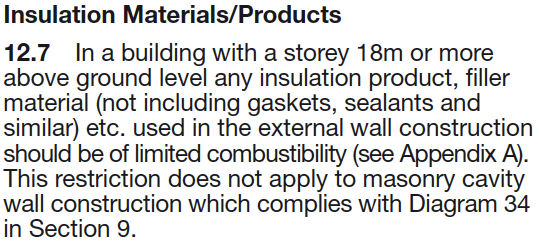








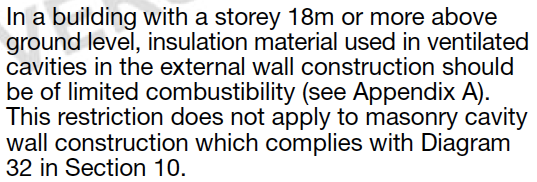






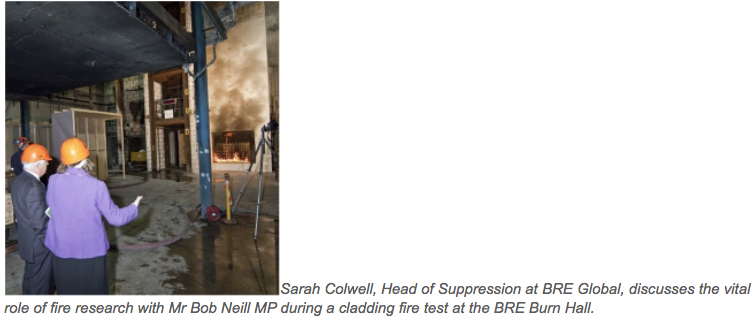
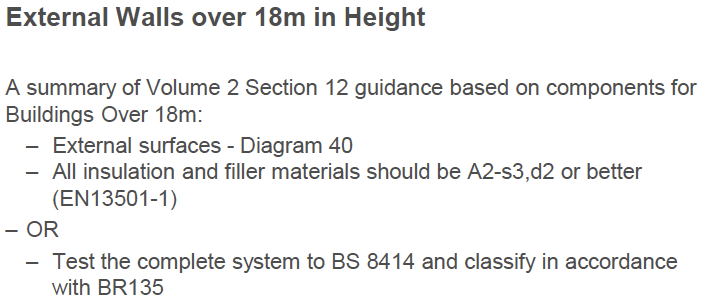

















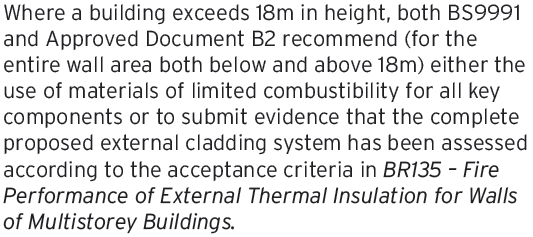




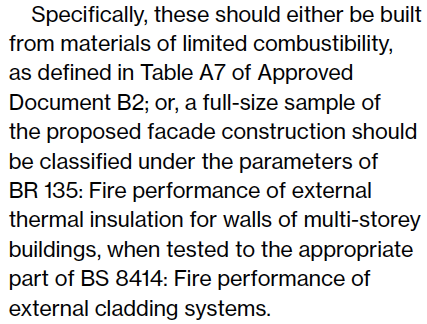
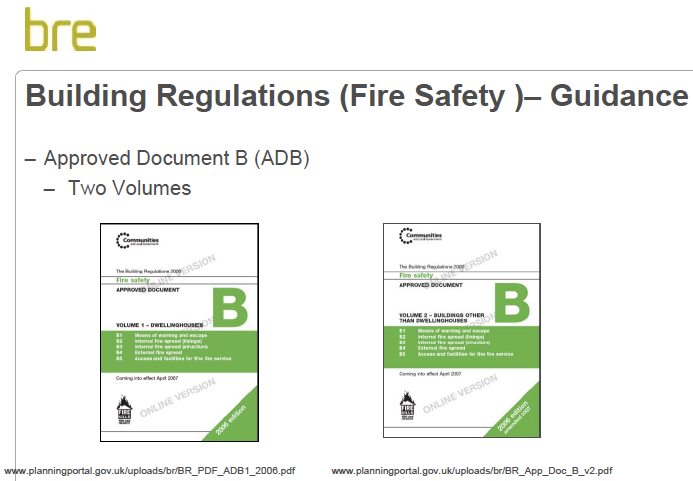



Are you familiar with the Europe wide Construction Products Regulations on the statute books of all European countries since July 2013. Part of these regulations require building product manufacturers to produce a DOP or Declaration of Performance on their products with fines of 450,000 euro or prison trerms for non compliance . There is no DOP available for the external cladding on Grenfell and the Celotex inner insulation states NPD or No Performance Determined
Hi Fiacre,
Thanks, yes, I wrote about this here: http://theriveroflife.com/2017/07/17/grenfell-tower-and-the-eu-north-booker-red-herrring-part-3/ (Section: ‘Harmonised and non-harmonised product types). I also wrote to St Gobain about it but didn’t receive a reply.
I thought that there was no harmonised standard for ACM panels and therefore the situation was different for these?
Andrew